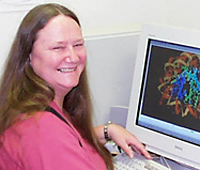
Professor of Biochemistry and Molecular Biology, University of Massachusetts
Email: mollyfh@biochem.umass.edu
M. Fitzgerald-Hayes Biochemistry & Molecular Biology Web Site
Ph.D.: University of Connecticut Health Center at Farmington
Postdoctoral Training: University of California at Santa Barbara
Honors: Distinguished Teacher Award nominee; National Institutes of Health Research Career Development Award; National Science Foundation Career Advancement Award; Damon Runyan-Walter Winchell Postdoctoral Fellowship
Chromosome Segregation and Centromere Function, Cell Cycle Control and Checkpoint Signaling
The people in my laboratory study how chromosomes which contain genetic information, move during cell division. Chromosome movement at mitosis is mediated by a specialized region of each chromosome called the centromere which interacts with the microtubules of the mitotic spindle. The focus of our research is directed at characterizing the DNA and proteins required for centromere function. We chose the yeast, Saccharomyces cerevisiae, as our model organism because this single-cell eucaryote divides rapidly and has well-characterized centromere DNA (CEN) and a relatively simple kinetochore structure. Yeast are amenable to a wide array of methodologies ranging from classical genetics to advanced recombinant DNA and biochemical techniques. In addition, the entire yeast genome has been sequenced, which has provided important genetic information and led to the identification of many yeast/human homologs.
We have devised genetic screens to identify proteins involved in centromere function and chromosome segregation. These screens have yielded several novel genes (CSE1, SRP1, PLC1), including the current focus of our work, CSE4. The essential gene CSE4 encodes a chromatin-associated protein with striking homology to histone H3 and the human centromere protein, CENP-A. We have constructed a wide array of mutations in the CSE4 protein (Cse4p) and have identified several other genes required for Cse4p function. These data indicate that Cse4p plays an important role in centromere function and cell cycle control. Currently, genetic and biochemical experiments are under way to analyze function when Cse4p replaces H3 in an evolutionarily conserved, specialized chromatin domain that is required for function of the eucaryotic centromere.Chromosome Segregation and Centromere Function; Cell Cycle Control and Checkpoint Signaling
Representative publications:
DeFalco, C., M. Fitzgerald-Hayes, J.C. Layzer, S.A. Weitze, Y. Chen, K.C. Keith and S. Stoler. Scm3p is a novel, essential yeast centromere protein that binds to the centromere-specific H3-like protein Cse4p. (Manuscript in preparation, 2000).
Chen, Y., R. E. Baker, K. C. Keith, K. Harris, S. Stoler and M. Fitzgerald-Hayes (2000). "The N terminus of the centromere H3-like protein Cse4p performs an essential function distinct from that of the histone fold domain." Mol Cell Biol 20(18): 7037-48.
Keith, K. C. and M. Fitzgerald-Hayes (2000). "CSE4 genetically interacts with the Saccharomyces cerevisiae centromere DNA elements CDE I and CDE II but not CDE III. Implications for the path of the centromere dna around a cse4p variant nucleosome." Genetics 156(3): 973-81.
Schroeder, A.J., Chen, X.H., Xiao, Z. and Fitzgerald-Hayes, M. Genetic evidence for interactions between yeast importin alpha (Srp1p) and its nuclear export factor, Cse1p. Mol.Gen.Genet. 261: 788-795 (1999).
Keith, K.C., R.E. Baker, Y. Chen, K. Harris, S. Stoler and M. Fitzgerald-Hayes. Analysis of primary structural determinants that distinguish the centromere-specific function of histone variant Cse4p from histone H3. Mol. and Cell. Biol. 19:6130-6139 (1999).
Xiao, Z. and Fitzgerald-Hayes, M. Functional interaction between the CSE2 gene product and centromeres in S. cerevisiae. J. Mol. Biol. 248:255-263 (1995).
Stoler, S., Keith, K.C., Curnick, K.E. and Fitzgerald-Hayes, M. A mutation in CSE4, an essential gene encoding a novel chromatin-associated protein in yeast, causes chromosome nondisjunction and cell cycle arrest at mitosis. Genes and Development. 9:573-586 (1995).
Chen, X.H., Xiao, Z., and Fitzgerald-Hayes, M. SCM2, a tryptophan permease in Saccharomyces cerevisiae, is important for cell growth. Mol. Gen. Genetics 244:260-268 (1994).
Payne, W.E. and Fitzgerald-Hayes, M. A mutation in PLC1, a candidate phosphoinositide-specific phospholipase C gene from yeast, causes aberrant mitotic chromosome segregation. Mol. Cell. Biol. 13: 4351-4364 (1993).
Xiao, Z., McGrew, J.T., Schroeder, A. and Fitzgerald-Hayes, M. CSE1 and CSE2, two new genes required for accurate mitotic chromosome segregation in S. cerevisiae. Mol. Cell. Biol. 13: 4691-4702 (1993).